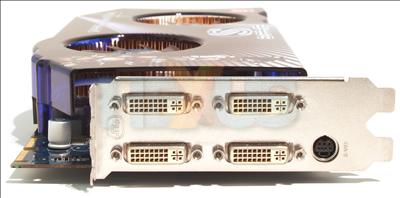Appearance and thoughts
We've seen Sapphire indulge in some dual-GPU action before, so amalgamating two GPUs on to one board isn't the technical challenge that it might be to a smaller AMD/ATI partner.
The large shroud is pierced by two fans that cover the underlying RV630 XT GPUs. The fans' speed is not thermostatically controlled, and we found them to be a little on the noisy side as a result.
Two 2000-series GPUs gives rise to some wonderful connectivity options. One can drive four dual-link, HDCP-enabled displays from a single PCIe x16 card, although only two ports will work with internal CrossFire mode enabled. The downside of having larger-than-normal coolers and a double-height back plate is manifested in a graphics card that will take up two expansion slots - the PCIe x16's and the one directly adjacent. The advantage here is that you don't need to have a motherboard with two separate (x16) slots, though.
We know that Radeon HD 2600 XTs feature a Unified Video Processor which helps in taking off the load on the CPU when decoding HD DVD and Blu-ray content. Whilst this card supports two such UVDs, only the master UVD works. Most of the display-related shortcomings are driver and not hardware issues, we note.
Taking away the cover shows us that the coolers do not concurrently cool the memory chips, however. Sapphire has chosen to outfit both with cores with 512MiB of GDDR3 memory each, making a total card frame buffer of 1024MiB, operating at 1584MHz, which is above the 'XT GDDR3-default speed of 1386MHz but below the 'XT GDDR4's 2196MHz.
In effect, then, the card can be viewed as two distinct Radeon HD 2600 512MiB XTs - operating at the default core speed of 796.5MHz but with faster memory -that are placed on to a single board. The connecting magic takes place via an interconnecting chip just below the left-hand GPU.
The rear of the board highlights a number of additional memory chips that make up the 1GiB frame buffer. Notice, too, the CrossFire fingers on the top-right portion of the above picture? Assuming that suitable drivers are released that take advantage of a quad-GPU setup, two of these cards can be configured in CrossFire, so CrossFire (two cards) on top of CrossFire (PCB).
A closer look at the PCB highlights one RV630 XT core. We also see the additional PCIe connectors required to power the extra wattage required by having, well, two of everything on a single PCB.
Noisy, noisy!
















